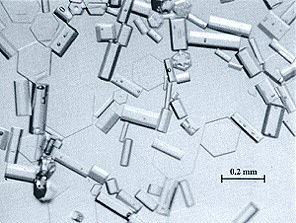
OPOD
What's New
Rays & Shadows
Water Droplets
Rainbows
Ice Halos
Contents
Crystals
Crystals & Halos
Columns & Plates
Orientations
Face numbers
Real Crystals
Diamond Dust
Pyramidal
Frequent Halos
Infrequent Halos
Multiple Displays
Other Worlds
Observing Halos
HaloSim
High Atmosphere
Links & Resources
Search - Index
123456789012345678
| Real Crystals |
 |
 |
|
| Crystals collected during a superb South Pole display on 17th January 1986. Apart from a few small air bubble inclusions, the crystals really are like their hexagonal plate and column ideals. | Crystals from a mediocre halo display 16 days earlier. They have large inclusions and their faces are imperfect. Photographs from 'Atmospheric Halos by Walter Tape' reproduced with permission. | |
Not all cirrus clouds produce halo displays. Why is this? When their ice crystals are smaller than ~0.01 mm (10 micron) light is significantly diffracted and any halos are weak and diffuse. Crystals larger than 0.05 mm refract and reflect light cleanly to produce halos. The sharpest halos occur when the crystals have precise alignments and this needs crystals larger than about 0.1 mm. Very large crystals of 1 mm or more are rarely of sufficient optical quality and have defects which spoil their halos. They also have an increasing tendency to wobble and lose their alignments. So the crystal sizes, alignments and optical qualities are sometimes not right to give good halos. But always check the skies for sometimes the conditions are perfect! |
||